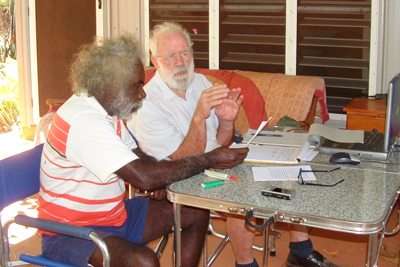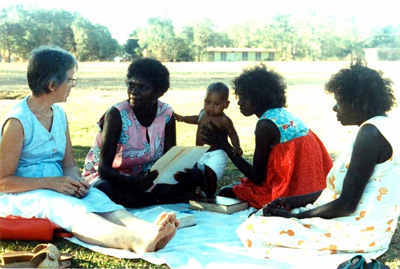
KARYN MARKWELL reports on a project aimed at taking the Bible to Indigenous Australians…
Indigenous Australians will soon be able to read the entire New Testament in simplified English – a basic version of English consistent with the linguistic and semantic features of Indigenous languages.
The Simplified English Version (SEV) Translation Project team includes translators from Bible Society SA, Bible League Australia, Wycliffe Bible Translators, Australian Indigenous Ministries and Church Missionary Society. Its purpose is to make the Bible more easily understood by Indigenous Australians, many of whom speak English as a second language.

REACHING OUT: Bible League Australia’s CEO Grahame Smith discusses an SEV passage with a man who speaks Ndjebbena, for which no Scripture has been translated.
JESUS’ DEATH IN SIMPLIFIED ENGLISH:
“Jesus yelled out again, and then he died. Over there in God’s house in Jerusalem there was a big curtain blocking off the sacred place. At the same time when Jesus died, that curtain just ripped into two pieces, right down the middle from top to bottom. At the cross, the boss of those Roman soldiers stood near Jesus, and when he saw how Jesus died he said, ‘I reckon this man really was the son of God.'” (Mark 15: 37-39, SEV)
“This is one of the most exciting projects I’ve ever been involved in,’ says Grahame Smith, the CEO of Bible League Australia. “We’re providing Indigenous Australians, for whom English is a second language, with a copy of the New Testament and parts of the Old Testament, in a translation they understand.”
This Bible translation project is crucial because there are currently no existing Bibles that serve the same purpose: no other translations are written in the style of English that conforms to the vocabulary, linguistics and semantics that are most widely used by Indigenous Australians.
Indigenous Australians, for example, rarely use a passive voice: many Aborigines wouldn’t understand the Biblical phrase, “Believe in the Lord Jesus Christ and you will be saved”. (Acts 16: 30-31). To ensure that Indigenous Australians comprehend the full meaning of this essential passage, SEV translators would need to render it as, “Believe in the Lord Jesus Christ and God will save you”. Furthermore, the English which is used by Indigenous Australians includes very few abstract nouns, such as ‘faith’, ‘salvation’ and ‘joy’, which are central to Christian teaching. These concepts must instead be expressed by verbs such as ‘to believe’ and ‘to save’ and adjectives such as ‘happy’.
Missionaries to Aboriginal people groups have always been aware that their audience has experienced difficulty in understanding the English Scriptures. The ideal solution is obviously to translate the Bible into every single Indigenous Australian language – but in reality there aren’t enough resources available to undertake such an enormous task. Translating the Bible into simplified English will help to bridge this chasm – at least until the resources are found to translate the Bible into each Aboriginal language.

ROADTEST: A translator testing her work.
Translation team coordinator Dave Glasgow provides an example of how the new simplified English translation is already having an effect: “When I was reading the SEV to a missionary, an Aboriginal bystander made the unsolicited comment, ‘That’s easy to understand. That’s really clear’.”’
Mr Glasgow says the younger Indigenous generation is also able to connect with the simplified English Bible. “A teacher at a Christian school for Aborigines, when ‘road testing’ the Easter story, reported that the children kept their attention right through the reading of the passage,” he recalls. “This was unusual. They usually get fidgety and start playing up after the first minute or two of listening to a reading.”
The first SEV publication, The Easter Story, came off the press in February 2010. The first draft of four New Testament books, plus around 20 other chapters from both the New and Old Testaments, have also been completed. Before a book is published, it must first undergo a rigorous checking process to ensure that Indigenous readers will fully understand every passage – and how the saving Gospel of Christ relates to his or her individual life.
“If we don’t understand what we are reading, the words are meaningless,’ says Mr Smith. ‘That’s why this is a ground-breaking project.”





